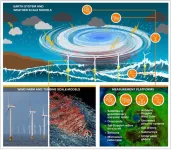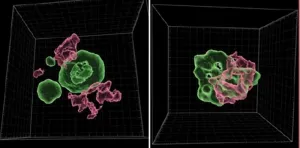(Press-News.org) CAMBRIDGE, MA – Active electronics — components that can control electrical signals — usually contain semiconductor devices that receive, store, and process information. These components, which must be made in a clean room, require advanced fabrication technology that is not widely available outside a few specialized manufacturing centers.
During the Covid-19 pandemic, the lack of widespread semiconductor fabrication facilities was one cause of a worldwide electronics shortage, which drove up costs for consumers and had implications in everything from economic growth to national defense. The ability to 3D print an entire, active electronic device without the need for semiconductors could bring electronics fabrication to businesses, labs, and homes across the globe.
While this idea is still far off, MIT researchers have taken an important step in that direction by demonstrating fully 3D-printed resettable fuses, which are key components of active electronics that usually require semiconductors.
The researchers’ semiconductor-free devices, which they produced using standard 3D printing hardware and an inexpensive, biodegradable material, can perform the same switching functions as the semiconductor-based transistors used for processing operations in active electronics.
Although still far from achieving the performance of semiconductor transistors, the 3D-printed devices could be used for basic control operations like regulating the speed of an electric motor.
“This technology has real legs. While we cannot compete with silicon as a semiconductor, our idea is not to necessarily replace what is existing, but to push 3D printing technology into uncharted territory. In a nutshell, this is really about democratizing technology. This could allow anyone to create smart hardware far from traditional manufacturing centers,” says Luis Fernando Velásquez-García, a principal research scientist in MIT’s Microsystems Technology Laboratories (MTL) and senior author of a paper describing the devices, which appears in Virtual and Physical Prototyping.
He is joined on the paper by lead author Jorge Cañada, an electrical engineering and computer science graduate student.
An unexpected project
Semiconductors, including silicon, are materials with electrical properties that can be tailored by adding certain impurities. A silicon device can have conductive and insulating regions, depending on how it is engineered. These properties make silicon ideal for producing transistors, which are a basic building block of modern electronics.
However, the researchers didn’t set out to 3D-print semiconductor-free devices that could behave like silicon-based transistors.
This project grew out of another in which they were fabricating magnetic coils using extrusion printing, a process where the printer melts filament and squirts material through a nozzle, fabricating an object layer-by-layer.
They saw an interesting phenomenon in the material they were using, a polymer filament doped with copper nanoparticles.
If they passed a large amount of electric current into the material, it would exhibit a huge spike in resistance but would return to its original level shortly after the current flow stopped.
This property enables engineers to make transistors that can operate as switches, something that is typically only associated with silicon and other semiconductors. Transistors, which switch on and off to process binary data, are used to form logic gates which perform computation.
“We saw that this was something that could help take 3D printing hardware to the next level. It offers a clear way to provide some degree of ‘smart’ to an electronic device,” Velásquez-García says.
The researchers tried to replicate the same phenomenon with other 3D printing filaments, testing polymers doped with carbon, carbon nanotubes, and graphene. In the end, they could not find another printable material that could function as a resettable fuse.
They hypothesize that the copper particles in the material spread out when it is heated by the electric current, which causes a spike in resistance that comes back down when the material cools and the copper particles move closer together. They also think the polymer base of the material changes from crystalline to amorphous when heated, then returns to crystalline when cooled down — a phenomenon known as the polymeric positive temperature coefficient.
“For now, that is our best explanation, but that is not the full answer because that doesn’t explain why it only happened in this combination of materials. We need to do more research, but there is no doubt that this phenomenon is real,” he says.
3D-printing active electronics
The team leveraged the phenomenon to print switches in a single step that could be used to form semiconductor-free logic gates.
The devices are made from thin, 3D-printed traces of the copper-doped polymer. They contain intersecting conductive regions that enable the researchers to regulate the resistance by controlling the voltage fed into the switch.
While the devices did not perform as well as silicon-based transistors, they could be used for simpler control and processing functions, such as turning a motor on and off. Their experiments showed that, even after 4,000 cycles of switching, the devices showed no signs of deterioration.
But there are limits to how small the researchers can make the switches, based on the physics of extrusion printing and the properties of the material. They could print devices that were a few hundred microns, but transistors in state-of-the-art electronics are only few nanometers in diameter.
“The reality is that there are many engineering situations that don’t require the best chips. At the end of the day, all you care about is whether your device can do the task. This technology is able to satisfy a constraint like that,” he says.
However, unlike semiconductor fabrication, their technique uses a biodegradable material and the process uses less energy and produces less waste. The polymer filament could also be doped with other materials, like magnetic microparticles that could enable additional functionalities.
In the future, the researchers want to use this technology to print fully functional electronics. They are striving to fabricate a working magnetic motor using only extrusion 3D printing. They also want to finetune the process so they could build more complex circuits
###
This work is funded, in part, by Empiriko Corporation.
END
MIT team takes a major step toward fully 3D-printed active electronics
By fabricating semiconductor-free logic gates, which can be used to perform computation, researchers hope to streamline the manufacture of electronics.
2024-10-15
ELSE PRESS RELEASES FROM THIS DATE:
Accelerated three-year medical school students perform as well as peers in traditional four-year programs
2024-10-15
Graduates who went to medical school for three years performed equally well on tests of skill and knowledge as their peers who followed a four-year program, a new study shows.
The accelerated three-year MD pathway offered by NYU Grossman School of Medicine beginning in 2013 was designed to help students earn their medical degrees sooner with reduced debt, which some experts say reaches $250,000 on average by graduation. The school was the first in the United States to offer a three-year MD program that ...
SwRI-developed instruments will study potential habitability of Jupiter’s moon Europa
2024-10-15
SAN ANTONIO — October 15, 2024 —Two Southwest Research Institute instruments were launched aboard NASA’s Europa Clipper spacecraft on Oct. 14 from the agency’s Kennedy Space Center. The spacecraft is designed to conduct a detailed reconnaissance of Jupiter’s moon Europa, investigating whether it could hold conditions suitable for life.
The SwRI-developed MAss Spectrometer for Planetary EXploration (MASPEX) and Ultraviolet Spectrograph (Europa-UVS) are among nine science instruments and a gravity science investigation that were developed to explore Europa, Jupiter’s fourth-largest ...
Proposed scoring system may enhance equity in organ transplantation, increase transplant rates and improve patient survival
2024-10-15
Tuesday, Oct. 15, 2024, Cleveland: Researchers at Cleveland Clinic and Case Western Reserve University (CWRU) have developed a new method that could potentially help provide better access to lung transplant for transplant candidates who are hard to match because of their blood type or height.
An analysis published in the Journal of Heart & Lung Transplantation showed significant inequity in lung transplant access based on these candidate characteristics and proposes a method for addressing it.
Lung transplant candidates require organs from donors of similar height and compatible blood type. Currently, to allow equally sick candidates equal ...
Survivors of childhood brain cancer are more likely to be held back in school
2024-10-15
In 2019, Raymond Mailhot was visiting with a young patient and his family facing a scary diagnosis – brain cancer. Treatments were incredibly effective, and the young boy was going to survive, Mailhot shared in Spanish with the Venezuelan immigrants.
But life would be disrupted at home, at the hospital, and at school, likely for months, he said.
“His story really made me want to dig deeper into the scholastic performance of survivors,” said Mailhot, M.D., M.P.H, an associate professor of radiation oncology at the University of Florida. “We discovered that survivors had twice the odds of being held back and performed significantly worse on state testing ...
Updating offshore turbine designs to reflect storms’ complexity is key
2024-10-15
WASHINGTON, Oct. 15, 2024 – The U.S. is ramping up plans for a major increase in offshore wind production, with 30 gigawatts of new installations expected by 2030 and a total of 110 gigawatts by 2050. But to be successful, the country needs to design turbines that can withstand the challenges of tropical storms.
“Extreme weather impacts on offshore wind turbines are not fully understood by the industry,” author Jiali Wang said. “Manufacturers design wind turbines based on international design standards, but better models and data are needed to study the impacts of extreme weather ...
Hospital strain during the COVID-19 pandemic and outcomes in older racial and ethnic minority adults
2024-10-15
About The Study: In this cross-sectional study, older adults hospitalized with sepsis were more likely to die or experience major morbidity as the hospital COVID-19 burden increased. These increases in adverse outcomes were greater in magnitude among members of minority populations than for white individuals.
Corresponding Author: To contact the corresponding author, Laurent G. Glance, MD, email laurent_glance@urmc.rochester.edu.
To access the embargoed study: Visit our For The Media website at this link https://media.jamanetwork.com/
(doi:10.1001/jamanetworkopen.2024.38563)
Editor’s Note: Please see the article for additional information, ...
Scientists unveils key role of “selfish DNA” in early human development
2024-10-15
A critical transition in early human development is regulated not by our own genes, but by DNA elements called transposons that can move around the genome, Sinai Health researchers have found.
This remarkable discovery challenges our previous understanding of these elusive DNA segments, shedding new light on the roles they play in human development and disease.
“People tend to think of transposons as akin to viruses where they hijack our cells for the sole purpose of propagating themselves,” says study’s senior co-author Dr. Miguel Ramalho-Santos, Senior Investigator at the Lunenfeld-Tanenbaum Research Institute (LTRI), part of Sinai Health, and Professor ...
Bonobos may be more vulnerable than previously thought, suggests genetics study
2024-10-15
Bonobos, endangered great apes that are among our closest relatives, might be more vulnerable than previously understood, finds a genetics study led by a UCL researcher that reveals three distinct populations.
The three groups of bonobos have been living separately in different regions in Central Africa for tens of thousands of years, according to the study published in Current Biology by an international research team co-led by UCL, University of Vienna, and Max Planck Institute for Evolutionary Anthropology ...
Scripps Research scientists discover chemical probes for previously “undruggable” cancer target
2024-10-15
LA JOLLA, CA—Hormone-driven cancers, like those of the breast and prostate, often rely on a tricky-to-target protein called Forkhead box protein 1 (FOXA1). FOXA1 mutations can enable these types of cancers to grow and proliferate. Today, FOXA1 is notoriously difficult to block with drugs—but that may soon change.
Scripps Research scientists have identified a crucial binding site on FOXA1 that could pave the way for future cancer treatments. The team’s findings, which were published in Molecular Cell on October 15, 2024, also mapped out how tiny drug-like chemical compounds—called small molecules—interact with the protein.
While ...
Giant Magellan telescope begins primary mirror support system testing
2024-10-15
TUCSON, AZ — October 15, 2024 — The Giant Magellan Telescope today announced the successful installation of one of its completed 8.4-meter-diameter primary mirrors into a support system prototype at the University of Arizona’s Richard F. Caris Mirror Lab. This highly sophisticated system — comparable in size to half a basketball court and containing three times the number of parts of a typical car — is vital to the telescope’s optical performance and precision control. The milestone marks the start of a six-month optical testing phase to demonstrate that the support system can control the mirror as required, validating the revolutionary capabilities ...
LAST 30 PRESS RELEASES:
Short-circuiting pancreatic cancer
Groundbreaking mapping: how many ghost particles all the Milky Way’s stars send towards Earth
JBNU researchers propose hierarchical porous copper nanosheet-based triboelectric nanogenerators
A high-protein diet can defeat cholera infection
A more accurate way of calculating the value of a healthy year of life
What causes some people’s gut microbes to produce high alcohol levels?
Global study reveals widespread burning of plastic for heating and cooking
MIT study shows pills that communicate from the stomach could improve medication adherence
Searching for the centromere: diversity in pathways key for cell division
Behind nature’s blueprints
Researchers search for why some people’s gut microbes produce high alcohol levels
Researchers find promising new way to boost the immune response to cancer
Coffee as a staining agent substitute in electron microscopy
Revealing the diversity of olfactory receptors in hagfish and its implications for early vertebrate evolution
Development of an ultrasonic sensor capable of cuffless, non-invasive blood pressure measurement
Longer treatment with medications for opioid use disorder is associated with greater probability of survival
Strategy over morality can help conservation campaigns reduce ivory demand, research shows
Rising temperatures reshape microbial carbon cycling during animal carcass decomposition in water
Achieving ultra-low-power explosive jumps via locust bio-hybrid muscle actuators
Plant-derived phenolic acids revive the power of tetracycline against drug-resistant bacteria
Cooperation: A costly affair in bacterial social behaviour?
Viruses in wastewater: Silent drivers of pollution removal and antibiotic resistance
Sub-iethal water disinfection may accelerate the spread of antibiotic resistance
Three in four new Australian moms struggle with body image
Post-stroke injection protects the brain in preclinical study
Cardiovascular risk score predicts multiple eye diseases
Health: estimated one in ten British adults used or interested in GLP-1 medications for weight loss
Exercise to treat depression yields similar results to therapy
Whooping cough vaccination for pregnant women strengthens babies’ immune system
Dramatic decline in new cases of orphanhood in Uganda driven by HIV treatment and prevention programs
[Press-News.org] MIT team takes a major step toward fully 3D-printed active electronicsBy fabricating semiconductor-free logic gates, which can be used to perform computation, researchers hope to streamline the manufacture of electronics.






